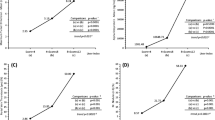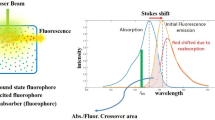Summary
There has been an ongoing search for clinically acceptable methods for the accurate, efficient and simple diagnosis and prognosis of hepatocellular carcinoma (HCC). Optical spectroscopy is a technique with potential clinical applications to diagnose cancer diseases. The purpose of this study was to obtain the optical properties of HCC tissues and non-tumorous hepatic tissues and identify the difference between them. A total of 55 tissue samples (HCC tissue, n=38; non-tumorous hepatic tissue, n=17) were surgically resected from patients with HCC. The optical parameters were measured in 10-nm steps using single-integrating-sphere system in the wavelength range of 400 to 1800 nm. It was found that the optical properties and their differences varied with the wavelength for the HCC tissue and the non-tumorous hepatic tissue in the entire wavelength range of research. The absorption coefficient of the HCC tissue (1.48±0.99, 1.46±0.88, 0.86±0.61, 2.15±0.53, 0.54±0.10, 0.79±0.15 mm−1) was significantly lower than that of the non-tumorous hepatic tissue (2.79±1.73, 3.13±1.47, 3.06±2.79, 2.57±0.55, 0.62±0.10, 0.93±0.16 mm−1) at wavelengths of 400, 410, 450, 1450, 1660 and 1800 nm, respectively (P<0.05). The reduced scattering coefficient of HCC tissue (5.28±1.70, 4.91±1.54, 1.26±0.35 mm−1) and non-tumorous hepatic tissue (8.14±3.70, 9.27±3.08, 2.55±0.57 mm−1) was significantly different at 460, 500 and 1800 nm respectively (P<0.05). These results show different pathologic liver tissues have different optical properties. It provides a better understanding of the relationship between optical parameters and physiological characteristics in human liver tissues. And it would be very useful for developing a non-invasive, real-time, simple and efficient way for medical management of HCC in the future.
Similar content being viewed by others
References
Parkin DM, Bray F, Ferlay J, et al. Estimating the world cancer burden: Globocan 2000. Int J Cancer, 2001,94(2): 153–156
Zhang SW, Li LD, Lu FZ, et al. Mortality of primary liver cancer in China from 1990 through 1992. Chin J oncology, 1999,21(4):245–249
Bruix J, Llovet JM. Prognostic prediction and treatment strategy in hepatocellular carcinoma. Hapatology, 2002,35(3):519–524
Johnson PJ. The role of serum α-fetoprotein estimation in the diagnosis and management of hapatocellular carcinoma. Clin Liver Dis, 2001,5(1):145–159
Wilder-Smith P, Holtzman J, Epstein J, et al. Optical diagnostics in the oral cavity: an overview. Oral Dis, 2010,16(8):717–728
Volynskaya Z, Haka AS, Bechtel KL, et al. Diagnosing breast cancer using diffuse reflectance spectroscopy and intrinsic fluorescence spectroscopy. J Biomed Opt, 2008,13(2):024012
Shah N, Cerussi AE, Jakubowski D, et al. The role of diffuse optical spectroscopy in the clinical management of breast cancer. Dis Markers, 2003–2004;19(2–3):95–105
van Veen RLP, Amelink A, Menke-Pluymers M, et al. Optical biopsy of breast tissue using differential path-length spectroscopy. Phys Med Biol, 2005,50(11): 2573–2581
Zhu C, Breslin TM, Harter J, et al. Model based and empirical spectral analysis for the diagnosis of breast cancer. Opt Express, 2008,16(19):14 961–14 978
Bigio IJ, Bown SG, Briggs G, et al. Diagnosis of breast cancer using elastic-scattering spectroscopy: preliminary clinical results. J Biomed Opt, 2000,5(2):221–228
Chang VT, Cartwright PS, Bean SM, et al. Quantitative physiology of the precancerous cervix in vivo through optical spectroscopy. Neoplasia, 2009,11(4):325–332
Chang SK, Marin N, Follen M, et al. Model-based analysis of clinical fluorescence spectroscopy for in vivo detection of cervical intraepithelial dysplasia. J Biomed Opt, 2006,11(2):024008
Mourant JR, Bocklage TJ, Powers TN, et al. In vivo light scattering measurements for detection of precancerous conditions of the cervix. Gynecol Oncol, 2007,105(2): 439–445
Georgakoudi I, Feld MS. The combined use of fluorescence, reflectance, and light-scattering spectroscopy for evaluating dysplasia in Barrett’s esophagus. Gastrointest Endosc Clin N Am, 2004,14(3):519–537
Katzilakis N, Stiakaki E, Papadakis A, et al. Spectral characteristics of acute lymphoblastic leukemia in childhood. Leuk Res, 2004,28(11):1159–1164
Mahlstedt K, Netz U, Schädel D, et al. An initial assessment of the optical properties of human laryngeal tissue. ORL J Otorhinolaryngol Relat Spec, 2001,63(6):372–378
Zonios G, Dimou A. Optical properties of human melanocytic nevi in vivo. Photochem Photobiol, 2009,85(1): 298–303
Zonios G, Dimou A, Bassukas I, et al. Melanin absorption spectroscopy: new method for noninvasive skin investigation and melanoma detection. J Biomed Opt, 2008, 13(1):014017
Zonios G, Dimou A, Carrara M, et al. In vivo optical properties of melanocytic skin lesions: common nevi, dysplastic nevi and malignant melanoma. Photochem Photobiol, 2010,86(1):236–240
Hsu CP, Razavi MK, So SK, et al. Liver tumor gross margin identification and ablation monitoring during liver radiofrequency treatment. J Vasc Interv Radiol, 2005, 16(11):1473–1478
Kitai T, Nishio T, Miwa M, et al. Optical analysis of the cirrhotic liver by near-infrared time-resolved spectroscopy. Surg Today, 2004,34(5):424–428
Holmer C, Lehmann KS, Wanken J, et al. Optical properties of adenocarcinoma and squamous cell carcinoma of the gastroesophageal junction. J Biomed Opt, 2007,12(1): 014025
Webber J, Herman M, Kessel D, et al. Photodynamic treatment of neoplastic lesions of the gastrointestinal tract. Recent advances in techniques and results. Langenbecks Arch Surg, 2000,385(4):299–304
Wei HJ, Xing D, Lu JJ, et al. Determination of optical properties of normal and adenomatous human colon tissues in vitro using integrating sphere techniques. World J Gastroenterol, 2005,11(16):2413–2419
Wei HJ, Xing D, Wu GY, et al. Differences in optical properties between healthy and pathological human colon tissues using a Ti:sapphire laser: an in vitro study using the Monte Carlo inversion technique. J Biomed Opt, 2005,10(4):44022
Wen X, Tuchin VV, Luo QM, et al. Control the scattering of Intralipid by using optical clearing agents. Phys Med Biol, 2009,54(22):6917–6930
Zhu D, Luo Q, Cen J. Effects of dehydration on the optical properties of in vitro porcine liver. Lasers Surg Med, 2003,33(4):226–231
Zhu D, Lu W, Zeng SQ, et al. Effect of light losses of sample between two integrating spheres on optical properties estimation. J Biomed Opt, 2007,12(6):064004
Nachabé R, Hendriks BHW, Desjardins AE, et al. Estimation of lipid and water concentrations in scattering media with diffuse optical spectroscopy from 900 to 1,600 nm. J Biomed Opt, 2010,15(3):037015
Maitland DJ, Walsh JT Jr, Prystowsky JB, et al. Optical properties of human gallbladder tissue and bile. Appl Opt, 1993,32(4):586–591
Meissonnier GM, Laffitte J, Loiseau N, et al. Selective impairment of drug-metabolizing enzymes in pig liver during subchronic dietary exposure to aflatoxin B1. Food Chem Toxicol, 2007,45(11):2145–2154
Fradette C, Du Souich P. Effect of hypoxia on cytochrome P450 activity and expression. Curr Drug Metab, 2004,5(3):257–271
Chen X, Cheung ST, So S, et al. Gene expression patterns in human liver cancers. Mol Biol Cell, 2002,13(6): 1929–1939
Pan C, Kumar C, Bohl S, et al. Comparative proteomic phenotyping of cell lines and primary cells to assess preservation of cell type specific functions. Mol Cell Proteomics, 2009,8(3):443–450
Roy L, Laboissière S, Abdou E, et al. Proteomic analysis of the transitional endoplasmic reticulum in hepatocellular carcinoma: An organelle perspective on cancer. Biochim Biophys Acta, 2010,1804(9):1869–1881
Ritz JP, Roggan A, Isbert C, et al. Optical properties of native and coagulated porcine liver tissue between 400 and 2400 nm. Lasers Surg Med, 2001,29(3):205–212
Author information
Authors and Affiliations
Corresponding author
Rights and permissions
About this article
Cite this article
Yu, Y., Xiao, C., Chen, K. et al. Different optical properties between human hepatocellular carcinoma tissues and non-tumorous hepatic tissues In Vitro . J. Huazhong Univ. Sci. Technol. [Med. Sci.] 31, 515–519 (2011). https://doi.org/10.1007/s11596-011-0482-4
Received:
Published:
Issue Date:
DOI: https://doi.org/10.1007/s11596-011-0482-4




